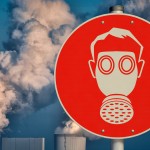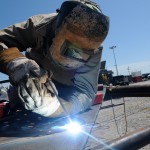Occupational safety does not end with exctraction: Dust disposal also entails hazards
Due to the health hazard of welding fumes, it is not sufficient to only rely on a good extraction and air filtration. Dust disposal also plays a large part. Here, the welder must be protected against hazardous substances in the same way as during welding.
The Ordinance on Hazardous Substances stipulates this clearly: “Dusts must be captured completely at the points of exit and origin and must be disposed of without any hazard”. After the suction of welding fume, several types of waste material can occur. These include filter materials impinged with dust, cleansed and isolated dust in dust extraction units or sludge ( for example after the wet cleaning of an electrostatic filter).
After WIG-welding, during separator cleaning in suction systems, large amounts of dust containing thorium oxide may be raised and breathed in. In this way, the welder may be exposed to a considerably higher concentration of hazardous materials than during the welding or grinding process itself.
According to the stipulations of the Ordinance on Hazardous Substances and the Closed Substance Cycle and Waste Management Act the dust must be disposed of in a sealed container. That means that for the protection of the environment,the dust must get into contact with neither the atmosphere nor with the ground water. Moreover, it must not get into contact with humans. Dangers exist in the cases of inhalation through the respiratory system, up-take through the mouth or absorption through the skin.
Therefore, in order to be optimally protected from hazardous substances, not only effective suction or filter systems are required. After filtration the dust particles must ideally be transported automatically into a sealed container. Only in this way, it can be guaranteed that the welder does not get into contact with the hazardous particles.





